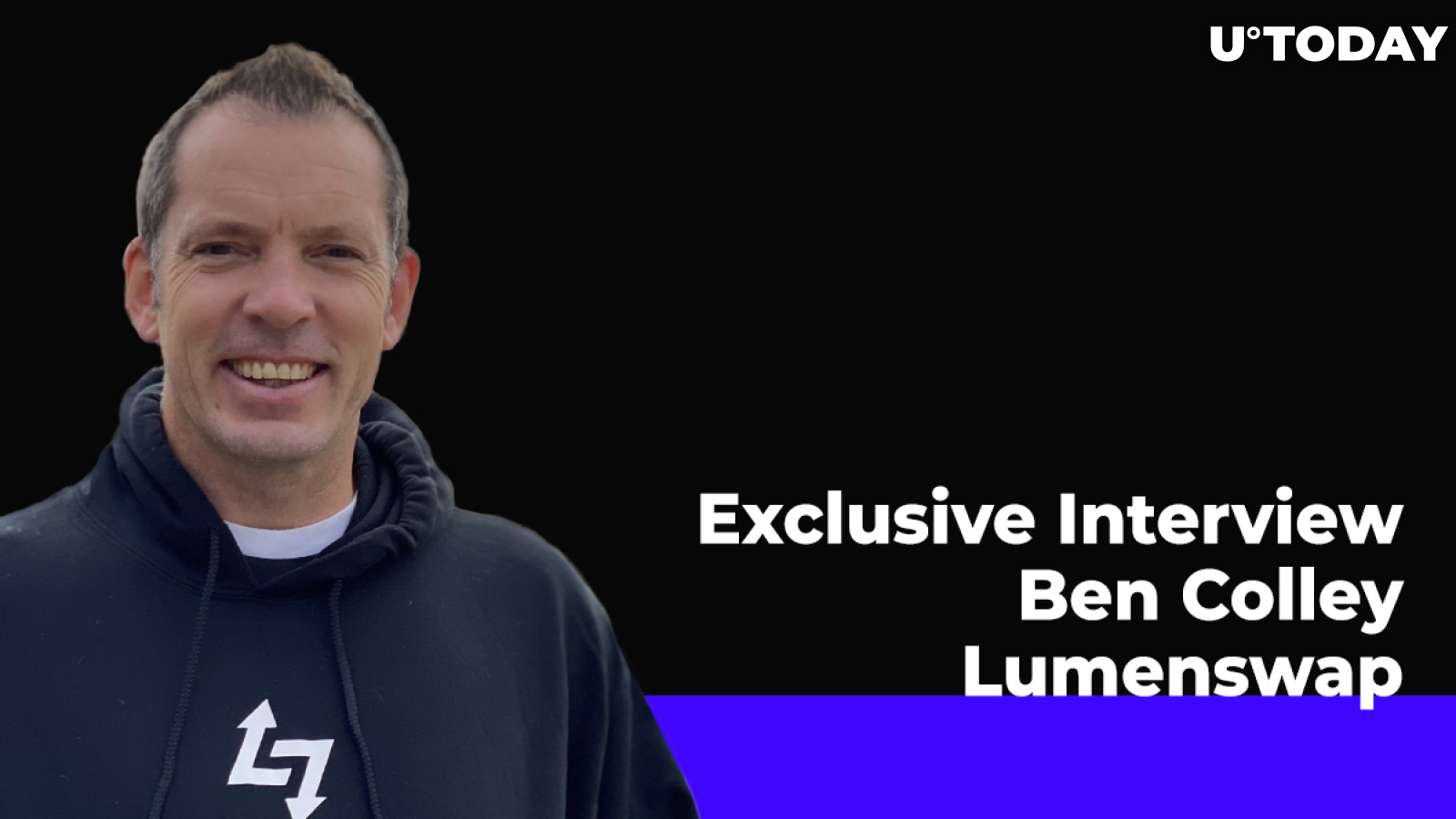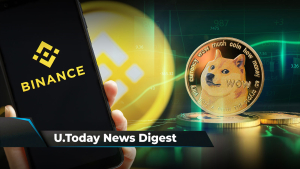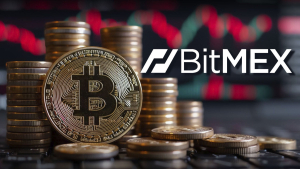Last week, I spoke to Ben Colley, the lead educator of Lumenswap and a big fan of crypto. He told me about their project, shared some important news and gave us an idea of how to protect the community from scams. Also, he made a guess about the Bitcoin price one year from now. (How much do you think it is? You can check your guess at the end of the article). Let’s dive into the interview!
U.Today: Ben, you're the lead educator of Lumenswap. What does that mean? How long have you been in the crypto space, and can you tell us a bit about your background?
Ben Colley: I certainly can. I have been in the crypto space since the spring of 2017. A friend of mine highlighted the fact that Bitcoin was an interesting concept. He was saying that it's a place where you can potentially make an investment, but also the idea behind it sounded interesting. He shared its history dating back to 2008, and then the Genesis block in 2009. So, I started having a little look in early spring, and I made an investment in Bitcoin in the late spring of 2017.
As I was doing my research, I was always kind of looking into the crypto space and trying to investigate a little bit more about what it actually did and what it was fundamentally trying to achieve. I was seeing at that time that there were a lot of people getting confused and scammed. I felt an obligation to help. In my work roles before, I've been in the public sector and I've also been a paramedic, so my roles in life have been to help people and to serve people. For this, it was pretty much the same.
I saw a lot of people getting scammed and a lot of people making mistakes. I decided that I was going to create an education platform with some basic understanding of cryptos: what they actually do, how you could store them, and how you can transfer them.
U.Today: What was it called?
Ben Colley: It was called Bullring Crypto . It was initially just a Facebook group. I just said to my friends on Facebook, if you're interested in the crypto space, if you are a little bit confused, then you can come to this group. What I'm going to do is a series of videos regarding information that I'm finding out. Of course it's not financial advice, but it's just the things that I'm finding out that might be of interest to you. This grew and grew, and then people were saying, “You need to do some courses, Ben.” So, I made a few basic courses just to help people in understanding investment fundamental analysis, technical analysis—very basic things. I'm not a trader, but I included some basic ideas around removing emotions. This was very popular and well received. It was very successful in late 2017. I really enjoyed it and got a lot out of being in the educational space of crypto. Of course, I made investments. I hodled various assets, but I just got a lot of satisfaction from helping people not get scammed and not make mistakes or lose their crypto. I developed a small reputation as someone who you could go to, to get accurate information with regard to crypto.
Then I had the lessons from 2018 to 2019. I needed to have those lessons, because I think greed had kind of encapsulated me from the end of the 2017 bull run, where I thought everything was just going to continue going up and we were going to see an explosion in the space. Of course, the opposite happened. We entered the bear market in late spring of 2018. And I watched my portfolio basically drained by about 90% in that time. So, as much as I'd helped people in terms of basic knowledge, I had been relatively greedy. I made some big mistakes—not taking profits, not following some of the things that I was researching. I wasn't following that necessarily. I was thinking this is going to be generational wealth and completely transform my family's lives. During that period, I took time to step back and reflect and think, “How can I actually do this better? How can I try to make it a better system, a better strategy?”
I went back to learning,deep-dive learning on different aspects of crypto. And where my passion fell was on decentralized finance. The whole explosion that began with Ethereum and Uniswap on Ethereum and the automated market-makers and that big movement into this new form of trading and swapping assets. It just fascinated me. So then that kind of evolved because I was learning more and more about that. I thought, right, I'll go back to my community that still existed. I went back to my community and said, “Look, I'm going to start teaching about ‘decentralized finance,’ about how you may be able to leverage it, how you can maximize some of the different aspects, from lending and borrowing, automated market-makers, yield farming, staking, all sorts of different things. I'm going to do this course over three months. I'll give you a module every day to help you to navigate the space because I think there is so much to learn.”
As you're well aware, the space moves so quickly, and even one day or one month in the crypto space is like a year out there in traditional finance and business. It moves so quickly. I needed to make sure that I was updating people as things were happening. Many of those people who did that course were very, very successful in the spring and early summer of this year.
Then I thought, I’ve been doing my own education, helping people, assisting people and doing webinars and all sorts of things, so I thought I would actually love to be part of a project. I would love to be contributing to a project that I had real passion about, that I thought could change the way that we transfer value and the way that we trade. Believe it or not,the universe works in mysterious ways.he day after I finished my course, I was just speaking to my wife and saying, “I wonder what I should do next in crypto. I've got real aspirations and passion to do this.” One of the projects I'd researched for my DeFi course was Lumenswap. It had been developed for 12 months, but it hadn't had its token-generation auction.
The developers were very much along the lines of: Let's build out first, let's bring a minimum viable product to the marketplace, and then let's do our token-generation auction. I had gone looking through Telegram and Twitter and doing a little bit of research. Then I just reached out to the team and said, “I really like this. And I know that you're relatively new in terms of building out your community and educating people on what you're trying to do. Can I contribute anything at all? I'm happy to do that for free. I just want to come into the space and be part of a team and maybe help some people.” Vladimir, our founder and CEO, said, “Yeah, there's a space for you to be an ambassador with us and contribute.”
I'm very much along the lines of bring value first before you expect anything in return. So, I just said, for one month, I'm going to try my hardest to create video content, to help the community with questions, to spread the word to my community that I'd already built and highlight some of the benefits of Lumenswap. Then, I kind of evolved into this role of lead educator. The way that I would summarize that because of the question that you've asked is that it’s my role to make sure that all of the ambassadors and the team are teaching and answering questions in a unified way. We're not having people come into the community, saying, “Oh, you're a chat moderator, you’re the Twitter manager, you’re the Reddit manager.” And they are confused and giving misinformation.
My job is to ensure that everyone is singing exactly the same hymn because what we're trying to create is quite complex.
It's multifaceted, with various aspects that are game-changing in the space and some that already exist. We're trying to ensure that the community is not getting the wrong message. I'm also in charge of educating the community. It's a matter of linking with the development team. We have two aspects, two wings of the bird. One is the development team and the technical team. And then one is the community team. I'm part of the community team, but I'm the chain that links the dev team to the community side. I get the information from the dev side. If we've got delays, if we have a new feature coming, if we have anything that they need publicised and that needs explaining, it comes down to me. Then I get to decide how we deliver that and how we break it down so that it's easy to understand.
You can appreciate yourself that crypto is particularly tricky for new people. We need to put it in language that people can understand. That's my role. It's four and a half years now of some degree of education and just three and a half months now of being part of Lumenswap. I joined them at the end of July. It's an exciting journey and I'm thrilled to finally be inside one of these crypto teams.
U.Today: Interesting. Lumenswap is a decentralized exchange built on the Stellar network. Why did they choose Stellar?
Ben Colley: They chose Stellar because Stellar's almost purpose-built for what we are trying to achieve. From my experience, when I go to a decentralized exchange, I want something to work. I don't want there to be challenges with RPC glitches. I don't want there to be challenges with speed. I want it to be fast and, ultimately, to be cheap. I've been on Uniswap myself and paid in excess of $300 in gas. When you try to look at something inclusive, one of the things with crypto is that they are trying to enable people around the world to transact value. We can't be inclusive to people in developing nations with those kinds of fees.
For me, Stellar is the perfect fit for a decentralized exchange because the time to finality of the ledger is 3-5 second fractions. For about $3.50, we can do about one million network operations on Stellar. If I were to do 100 operations per day, I could do operations for 30 years with just about $3, which is absolutely insane. I mean, it's virtually zero gas, it's virtually free to use. It's so, so quick. Of course, there's the fact that Stellar is also the frontrunner in trying to partner with the centralized world. They've just had a partnership with MoneyGram, which is going to open up 150 million users to the Stellar network.
They're trying to fit in that very difficult gap between the decentralized world and the centralized world, trying to make that bridge between the two possible.
That being said, Stellar, for us, is a P2P network for transactions, so we can send very low cost, fast transactions to each other. I think it's just perfectly primed for DeFi. It's the next evolution after Uniswap, and PancakeSwap tried to do what Uniswap did, but a little bit better. I think with Lumenswap, we are trying to do what those two have done well, but doing it better, doing it so it's more inclusive for the global community.
U.Today: What are Lumenswap’s criteria for listing tokens?
Ben Colley: The first thing we look at is the legitimacy of the project. We look at their history, how new the project is and the founders of the project. We try and open conversations with the team themselves to see what are their aspirations, what are their goals and what they are looking to achieve? The community is very important; what community platforms do they currently have? Do they have an engaged community? These are all tick boxes. We're not going to list all of the same type of token. we're not going to list 5 NFT tokens without looking at many other tokens and projects. It might be that there's some DeFi tokens, and there's some other tokens that are involved in logistics, or whatever it might be.
We would kind of look at each one of their individual merits but, essentially, look at the team, look at the legitimacy of the project, look at the community, have a conversation, see what their aspirations are, and then we would go from there.
U.Today: Does Lumenswap have any major plans for upgrades in the near future?
Ben Colley: We are in a really exciting time at the moment. Tomorrow is probably the biggest day in all of Lumenswap’s history, according to the VP of operations, Justin Rice, at Stellar Development Foundation this could be the biggest upgrade to Stellar in 7 years!For the first time in crypto history, there are going to be automated market-makers built in at L1 protocol level. And what this means for people who don't understand that is, instead of having a protocol on top of a network like Uniswap or PancakeSwap, you’ve actually got the automated market-makers built in the same as we have with the Stellar Dex.
We have the DEXes built into the network; this removes much of the smart contract risk that we would have, the team risk, the platform risk, the rug risk. All of that risk is really mitigated because you're interacting with the network. You are not dealing with a third party protocol. This will be voted on tomorrow. Now, they've gone about this in a different way: instead of having the vote and then letting the teams build, they've given the teams the testnet to build on already. Many projects, including Lumenswap, have already built out all of their access points for their clients so that we can interact with this automated market-maker on the Stellar network immediately after the launch. That's a very exciting thing for us to be welcoming.
What I see as the core aspects, the nucleus of decentralized finance, are automated market-makers and liquidity pools. That's what really set Ethereum on it’s crazy defi run over the last couple of years since Uniswap launched AMM’s. For us, it's the first step, and that's really exciting.
We've got a secret feature. By the time you publish this, it will have been launched. So I can tell you that we're going to have an NFT marketplace with Lumenswap. We've just released the first lottery—the first decentralized lottery on the Stellar network as part of Lumenswap’s ecosystem. We're looking at having a bridge from Binance Smart Chain and Ethereum over to the Stellar network using Lumenswap. We're also creating a lending and borrowing client in early 2022. Lastly we're building an auction incubator, which is going to help project managers and developers who want to build on Stellar to come to us, to use our very successful token-generation auction that we had back in July. This will use English or Dutch auctions so they can then catapult themselves onto the Stellar network in the same way that Lumenswap did back in the summer.
U.Today: Can you tell us something about Lumenswap that you are most proud of?
Ben Colley: I'm really proud of the community and really proud of the development. Personally I think I am most proud of the timely development and the way that the development team is open to pivoting. In many projects, there is a roadmap, and they say “This is the roadmap. This is what we're doing, and nothing else, for the next 18 months.” What Lumenswap is doing is listening to the community, which is filled with intelligent and knowledgeable people. And the developers are saying, if the community wants to incorporate a certain aspect of what they love within crypto, we're going to seriously look at the feasibility of that.
To be open-minded enough as a dev and technical team to be pivoting as crypto changes, that enables us to incorporate any changes in the future. We can’t know what’s going to happen within crypto in the next year, two or even three years. To be part of a project that is going to listen to the community and look at the technical aspects of developing these into the Lumenswap ecosystem is so exciting. It's like you're waking up every day thinking, how can we build more? How can we give more, how can we bring more value to the table? It's such an exciting role to be in.
U.Today: That's great. Now, I also have a few personal questions. Which companies or leaders in the industry do you respect the most?
Ben Colley: Oh, that's a great question. I think I could name lots, and I don't really want to go through a whole wacky list. What I'm going to say first off is that I have a huge amount of respect for the early Ethereum. Dr. Gavin Woods, Vitalik Buterin, Charles Hoskinson—these guys, I think, are game-changers. As much as I can be negative toward Ethereum gas costs, sluggishness, the problems that they're having in terms of scalability, etc., I also have to say they're the forefathers of our ability to build this exciting decentralized finance and for us to be our own banks and to reclaim our financial sovereignty. They are like the kings.
Now, of course, they've gone off on their own project. Charles is in ADA and they've just had smart contracts and that's a really exciting, superb project for the future, and they're working in Africa and other places. I find it completely and utterly inspiring when I look at everything that's happening there. Of course, not forgetting Dr. Gavin Woods, with Dot, and the parachains coming in just a couple of days’ time to Polkadot. We've already seen what is happening with Kusama and Moonriver/Moonbeam. They're saying that they’re not competitors of Ethereum, but there's certainly going to be another revolution when the parachains go live and that whole ecosystem starts building out. That's going to be absolutely fascinating. And, of course, NFT is going to be a really exciting movement as well over the next year or more.
But the one that I would say is current and kind of epitomizes where my mindset is, is Do Kwon, and Daniel Shin of Terra and, of course, its LUNA token. I believe that in decentralized finance, we should have decentralized stablecoins. I think that to have centralized stablecoins in decentralized finance is kind of weird, and for us to be relying on that collateralized paper…We've had many questions around USDT and audits and USDC, and seeing how these are actually backed.
I think what we've got with the whole Terra money, the world that they're building, there's about 160 projects to be launched in the next six months with Luna and UST involvement in some way, shape or form. That in itself, 160 projects launching, is just monumentally big. Because of this balancing, this kind of algorithmic stablecoin where it is decentralized, and you're going to be burning the LUNA to mint the UST and vice versa, you're going to have this kind of elastic method. It's fascinating to me. It really is. I think we're already seeing a two or three billion circulating supply of UST—it’s the fourth or fifth stablecoin at the moment, and I could really see it going up and being a top 10 stablecoin in the next couple of years, as more people move to a decentralized stablecoin rather than having this centralized version. Those guys are probably the most inspiring at the moment.
U.Today: What crypto do you have in your personal portfolio?
Ben Colley: Oh, this is an interesting one. My biggest bag, just by a fraction, is LSP. So, Lumenswap. I'm heavily invested in the project as much as a passionate fan and a team member. I really do think there's great room to grow. Then, it's going to be blue chips. So, I have Bitcoin, I have Ethereum, and these are kind of locked down long term. I don't use these. They're far too expensive for me to be sending on a daily basis, but they're my gold and silver holdings. Then the next biggest would be LUNA, as I just mentioned— an incredible projects with lots of potential. I also moved into ADA. Again, I think ADA and DOT have very bright futures.
Then, I kind of move into these high-risk…So my portfolio is stretched across blue chips and some more high-risk, exciting projects. I like NFT Champions that's just launched with some of the top designers from the gaming industry—Champ tokens, with one of the very, very low market caps. But I keep my eyes open and try to find exciting projects that I think have exciting futures. I try to balance that portfolio across many different coins and tokens…although all of crypto is extremely volatile, I would say that some of the smaller, lower market caps have got extremely bright futures in terms of how much they can grow in relation to Bitcoin and ETH. I've got some limitations on how much their market cap can grow, certainly over the next 6-12 months.
U.Today: How can we reduce scam projects on the crypto market, in your opinion?
Ben Colley: I think the way that we reduce scams is with clear education—that’s the number one for me. As soon as we have any layers of complexity, people glaze over and lose interest. I think if we have places where you can get educated, increase your experience, your knowledge of subject matter, then you will be less likely to be scammed. We need that easy education that people can access and work out what crypto is and how they can store it and also how they can send it. If that happens, we are going to reduce the amount of people being scammed.
But we need to address greed because greed and FOMO are two of the reasons why people make mistakes. They rush. They don't think about things. They rush into things without doing proper research just because the masses are doing it and they go crazy and get into it too. And they make mistakes. They sent their assets to the wrong address, or they've put their private keys into one of these fake websites, or they've done something stupid that they probably would not have done just because they're rushing. So I think what we must understand is that there's always going to be the next crazy crypto growth.
We don't know what projects are going to go up 10, 20, 100, 200, 500% over the next few months. But we know there will be many. It's a matter of patience...stepping back, getting educated and putting some time into your own knowledge and education. I think that can dramatically help people not get scammed.
U.Today: And the last question: What do you think the Bitcoin price will be one year from now?
Ben Colley: I think if everything stays constant in terms of crypto adoption, and institutional interest we will see an appreciation of the Bitcoin price. This is of course based on the fact that we don't see anything too crazy from global financial markets. If this happens then I think we could see an overall market cap in excess of 5 trillion next year. Using a yardstick of 40% dominance a Bitcoin MC of $2 Trillion. This would put Bitcoin at between $100 - 110k and I feel this could be very modest in 2022.
U.Today: Thank you so much for your time, Ben. It was a pleasure to speak with you.










